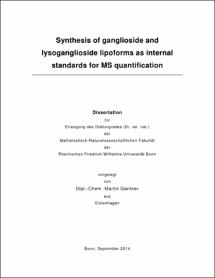Gantner, Martin: Synthesis of ganglioside and lysoganglioside lipoforms as internal standards for MS quantification. - Bonn, 2015. - Dissertation, Rheinische Friedrich-Wilhelms-Universität Bonn.
Online-Ausgabe in bonndoc: https://nbn-resolving.org/urn:nbn:de:hbz:5n-38756
Online-Ausgabe in bonndoc: https://nbn-resolving.org/urn:nbn:de:hbz:5n-38756
@phdthesis{handle:20.500.11811/6394,
urn: https://nbn-resolving.org/urn:nbn:de:hbz:5n-38756,
author = {{Martin Gantner}},
title = {Synthesis of ganglioside and lysoganglioside lipoforms as internal standards for MS quantification},
school = {Rheinische Friedrich-Wilhelms-Universität Bonn},
year = 2015,
month = jan,
note = {The goal of this work was to establish methods for the synthesis of modified gangliosides that are suitable as internal standards for mass spectrometry. Quantification of gangliosides is usually achieved by staining after chromatographic separation, most often by thin layer chromatography and subsequent densitometric analysis. These procedures are usually not suitable for the determination of different lipoforms of a given ganglioside. Within the recent years, ganglioside patterns have been increasingly analyzed by mass spectrometry due to the high sensitivity and specificity of this method. Due to the lack of suitable standard substances for internal calibration, MS gives no reliable information on the amount of complex gangliosides in samples of biological origin: Standard substances are only available for gangliosides GM1, GM2, and GM3. During this work structural analogs of the brain gangliosides GM1, GD1a, GD1b, GT1b, and GQ1b have been prepared from mixtures of bovine brain gangliosides. Also standard substances for the tumor-associated gangliosides GM2 and GD2 have been prepared. They are important targets for immunotherapy because they are highly expressed on human tumors of neuroectodermal origin while they are only minor gangliosides in healthy tissue. Furthermore, the quantification of GM2 is of interest in lysosomal storage diseases. In addition, a method based on an olefin metathesis has been established that is suitable for the synthesis of modified lysogangliosides. By this, non-natural lipoforms have been prepared that are suitable as internal standards for lyso-GM1 and lyso-GM2. These substances are potential biomarkers for GM1-gangliosidosis and GM2-gangliosidoses and the lysoganglioside standards prepared in this work can be used for their quantification. Currently, the standard substances are applied for the analysis of the brains of genetically engineered mice with deficiency of ceramide synthase 4.},
url = {https://hdl.handle.net/20.500.11811/6394}
}
urn: https://nbn-resolving.org/urn:nbn:de:hbz:5n-38756,
author = {{Martin Gantner}},
title = {Synthesis of ganglioside and lysoganglioside lipoforms as internal standards for MS quantification},
school = {Rheinische Friedrich-Wilhelms-Universität Bonn},
year = 2015,
month = jan,
note = {The goal of this work was to establish methods for the synthesis of modified gangliosides that are suitable as internal standards for mass spectrometry. Quantification of gangliosides is usually achieved by staining after chromatographic separation, most often by thin layer chromatography and subsequent densitometric analysis. These procedures are usually not suitable for the determination of different lipoforms of a given ganglioside. Within the recent years, ganglioside patterns have been increasingly analyzed by mass spectrometry due to the high sensitivity and specificity of this method. Due to the lack of suitable standard substances for internal calibration, MS gives no reliable information on the amount of complex gangliosides in samples of biological origin: Standard substances are only available for gangliosides GM1, GM2, and GM3. During this work structural analogs of the brain gangliosides GM1, GD1a, GD1b, GT1b, and GQ1b have been prepared from mixtures of bovine brain gangliosides. Also standard substances for the tumor-associated gangliosides GM2 and GD2 have been prepared. They are important targets for immunotherapy because they are highly expressed on human tumors of neuroectodermal origin while they are only minor gangliosides in healthy tissue. Furthermore, the quantification of GM2 is of interest in lysosomal storage diseases. In addition, a method based on an olefin metathesis has been established that is suitable for the synthesis of modified lysogangliosides. By this, non-natural lipoforms have been prepared that are suitable as internal standards for lyso-GM1 and lyso-GM2. These substances are potential biomarkers for GM1-gangliosidosis and GM2-gangliosidoses and the lysoganglioside standards prepared in this work can be used for their quantification. Currently, the standard substances are applied for the analysis of the brains of genetically engineered mice with deficiency of ceramide synthase 4.},
url = {https://hdl.handle.net/20.500.11811/6394}
}






